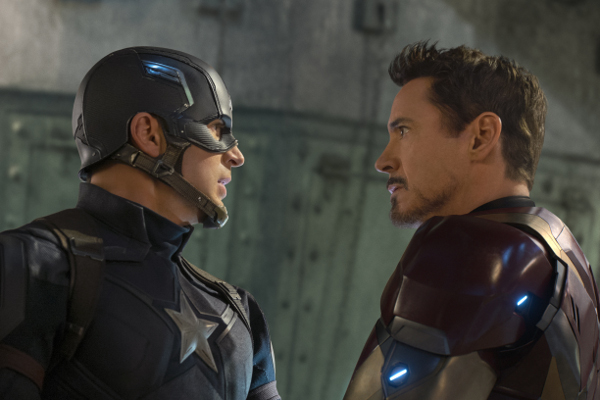
– By Cate Marquis –
CAPTAIN AMERICA: CIVIL WAR launches summer blockbuster season strong
Now is the winter of our discontent made glorious summer blockbuster season by “Captain America: Civil War.”
OK, just playing – “Captain America: Civil War” is no where near Shakespearean but the entertainment action film from Marvel/Disney is a comic book epic a cut above others on the genre, and a strong start for the summer season of action blockbusters. In fact, it may be the best of the Marvel movies yet.
“Captain America: Civil War” is a lot more entertaining than action movies that depend only on endless special effects battles, which all seem the same after awhile. Marvel certainly knows how to do these special effects-laden fantasy movies right, with its mix of action and heroics leavened with the right about of wise-cracking and character interactions. But this one adds something more, a little real-world reflection on accountability.
Chris Evans returns as Captain America/Steve Rogers along with Robert Downey Jr. as Iron Man, aka Tony Stark, who eventually lead opposing teams of Marvel superheros. The cast includes Anthony Mackie as Captain America pal Sam Wilson and Don Cheadle as Iron Man buddy Lt. James Rhodes, plus Scarlett Johansson, Jeremy Renner, Chadwick Boseman, Paul Bettany, Elizabeth Olsen, Sebastian Stan, William Hurt, Martin Freeman, and Daniel Bruhl.
The film begins with Captain America and his team battling adversaries, in an urban setting and often in close hand-to-hand combat. The melee ends with loss of civilian life when one hero steps in to save another from a bomb. That incident, and ones in the previous Marvel movie “Avenger: Age of Ultron,” lead to international political pressure to put the Avengers under some kind of civilian control. Oversight by a special United Nations committee is proposed, an idea supported by Tony Stark (Downey), in his businessman persona. Stark sets out to persuade each Avenger to sign on, with the biggest misgivings coming from Captain America (Evans). Both sides make valid arguments – there are dangers in ceding control to governments that may have their own agendas versus the danger of the superheros narrowly focused on their own fight and losing sight of destruction and human costs in its wake. Superheros Black Widow (Johansson), Hawkeye (Renner), Vision (Bettany) and Scarlet Witch (Olsen) must decide which view they support.
Eventually the superheros line up in two opposing camps, led by Captain America and Iron Man. “Eventually” because it is almost half way through the movie before the superhero civil war finally starts. After its opening action sequence, the first half of the movie is mostly devoted to discussions among the superheros, on the merits and hazards of putting them under some governing control, and the efforts of each side to persuade the other. The idea that the world might worry about a team of powerful enforcers meting out justice based on their own judgment is surprisingly real-world for a comic book movie, which usually exists in a world where the public is completely trusting and grateful for any protection superheros provide.
For fans of comic book action and flashy special effects, directors Joe and Anthony Russo and scriptwriters Christopher Markus and Stephen McFeely deliver the entertainment goods, with the action and snappy patter expected. The “civil war” truly gets underway with a terrific battle at an airport, where the film brings together bunch of characters from the Marvel “universe,” including a new, much younger Spider-Man (Tom Holland) and Ant-Man (Paul Rudd) who both add a freshness and extra bit of humor. The only major absentees are Thor and the Hulk.
The visual effects for this battle work well, which is also true for the film’s other large-scale fights, although the 3D effect does not really add anything special. However, the use of 3D actually seems to work against any feeling of realism in the earlier, close-quarters battles. The action is shot in typical over-the-shoulder, close-in action style, a technique that creates a sense of immediacy and tension in conventional film, but in 3D, it creates smeary visuals and a stuttering effect in which characters jump from spot to spot, at least for some viewers/ The effect is irritating and unpleasant, even more than the kind of dizziness created sometimes with hand-held camera work, and distracts and detracts from any sense of realism the scenes could have had.
Once the big battle kicks things off, the movie blasts non-stop towards its end, making its nearly 2 1/2 hour running time hardly noticeable. The actors all play their parts well enough, and Johansson has a nice featured part, a pleasant bonus for the male-dominated comic book genre. Downey is good as always, generally the film’s best. Reportedly, the part of Iron Man was expanded, so that he and Evans are more like co-stars, which works well for the story. Paul Bettany is sort of ethereal in his part but Elizabeth Olsen ia a bit one-note despite a fairly large part. Rudd, and Holland as a rebooted Spider Man, bring the most humor to the film in their smaller parts, with the bits between Downey and Holland especially fun. The film also introduces Chadwick Boseman as Black Panther.
“Captain America: Civil War” is more Marvel Universe than Captain America but it is a sure-fire hit that gives the summer entertainment season a strong launch, and demonstrates that Marvel and Stan Lee are still the kings of this kind of movie making.
© Cate Marquis
